Berries That Grow On Trees (Including Blackberry Lookalikes) – With Pictures and Identification Guide
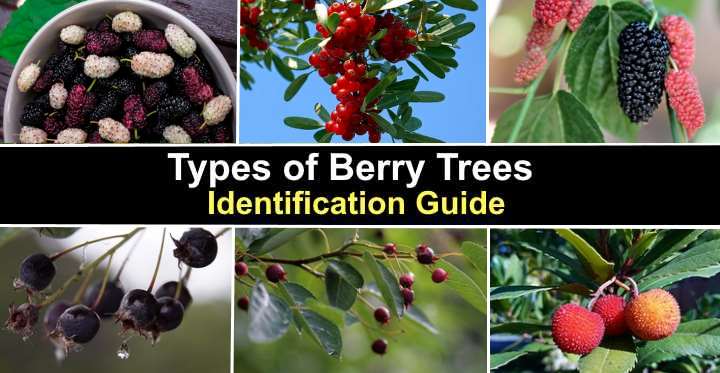
Berries that grow on trees are surprisingly uncommon in the botanical world. The most well-known tree that produces edible berries is the mulberry tree with its blackberry-like fruit. Other types of edible berries that grow on trees are hackberries, silver buffaloberry, serviceberry, Panama berry, and fruit on the strawberry tree.
Growing trees with edible berries in your garden is an excellent idea for their tasty, sweet, or tart fruit. Berry-producing trees typically have stunning spring flowers and attract plenty of wildlife. In spring, pollinators will fill your garden landscape, and then in summer and spring, the juicy berries will attract birds.
This article is a guide to the varieties of berries that grow on trees. Along with pictures and descriptions of the tree berries, you will learn how to identify tree features like their leaves, bark, and flowers.
What Berries Grow On Trees
Berry-producing trees with small, edible pulpy berry-like fruit include mulberries, hackberries, buffaloberries, serviceberries, Panama berries, and tree strawberries.
A berry is a small, pulpy fruit that grows from the ovary of a single flower. This creates a fleshy covering around the seeds.
Berries that grow on trees can be edible or inedible. When growing trees that produce berries in your yard, it’s best to choose edible varieties, especially if you have children.
Although most types of berries grow on shrubs, bushes, or thickets, some varieties grow on trees.
Many people refer to almost any tiny fleshy fruit as a berry. But, of course, there are many other fruit-producing trees with berry-like fruit. However, fruit trees like cherry trees, plum trees, and peach trees produce drupes — fleshy fruits with a large stone in the center.
Do Blackberries Grow On Trees?

Blackberries
Blackberries (Rubus) are small fruits that grow on thorny shrubs and look like black raspberries. Because blackberries look like mulberries, some people mistake a mulberry tree for a blackberry tree. Also called brambles, the blackberry plant is a large shrub with multiple cane-like stems and large, palmately compound leaves.
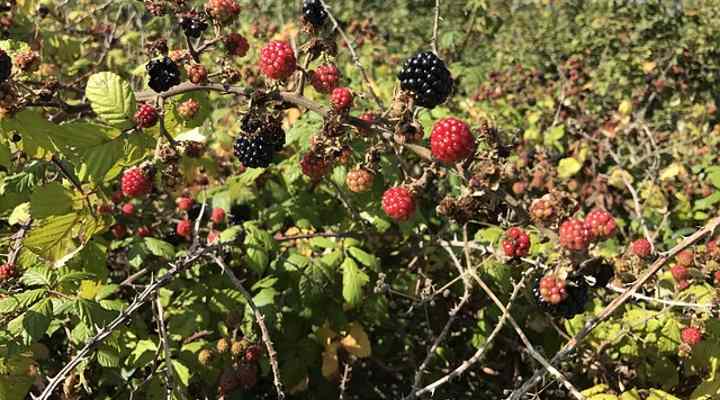
Blackberry shrub
Blackberries taste slightly tart before they are fully ripe. As they ripen, they become sweeter, and a ripe blackberry has incredibly soft flesh and a sweet taste. Blackberries also have a slightly earthy flavor due to their solid core, which some people find unpalatable.
Mulberry Tree – Tree With Berries That Look Like Blackberries
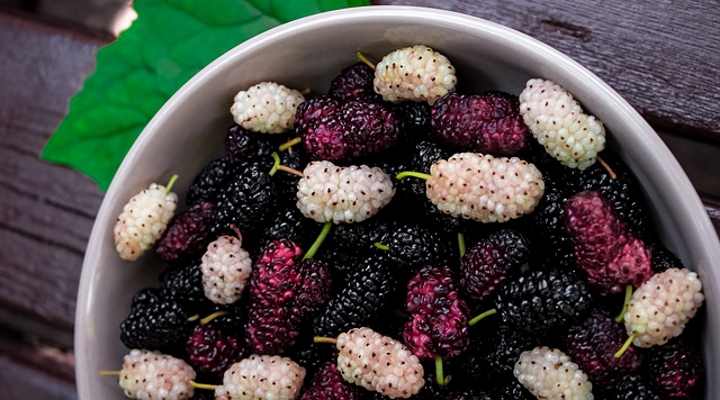
Mulberries
The mulberry tree produces fruits that look like blackberries. Mulberries (Morus) are black berries that grow on trees, however, you shouldn’t confuse them with similar-looking and tasting blackberries (Rubus). Blackberries are edible berries that grow on thorny shrubs, not trees. Although both types of berries are black and taste similar, mulberries are larger with a more elongated cylindrical shape.
Mulberries and blackberries differ slightly in their color. Blackberries are always oval to barrel-shaped and have shiny jet-black color when they are ripe. On the other hand, ripe mulberries can be red, red and black, or pure black. Mulberries tend to be larger than blackberries.
The most common mulberry tree is Red mulberry (Morus rubra) that has sweet, juicy red or black berries. White mulberry (Morus alba) has blackberry-like edible fruits that are white when immature and turn pink, red or purple-black as they ripen. Black mulberry (Morus nigra) has clusters of small black and tasty mulberry berries.
Types of Berries That Grow on Trees (With Pictures) – Identification Guide
Let’s look in detail at various kinds of edible berries that grow on trees.
Mulberry (Morus)
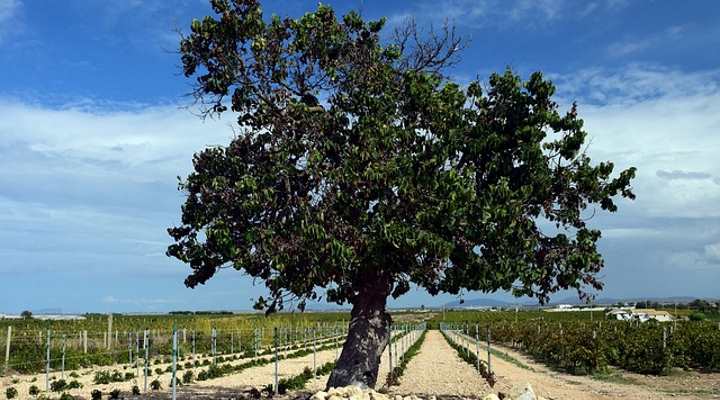
Old mulberry tree
Mulberry tree produces fruit that resembles blackberries. Mulberries are red, white, or black edible fruits that grow up to 1” to 3” (2.5 – 7.5 cm) long. Mulberries have a distinct cylindrical appearance, sometimes looking like a hooked finger. Typically, the color of mulberry fruit indicates its ripeness and sweetness, with black berries indicating the sweetest and ripest fruit.
Mulberry fruit starts to form on the mulberry tree after flowering. In summer, oval, white berries appear on the tree that gradually ripen, changing color and becoming sweeter. By the end of summer, mulberry fruit is ready for eating straight off the tree. The darker the color, the sweeter the berry-like tree fruit will taste.
Different species of mulberry ripen at various times. For example, the berries from the white mulberry tree (Morus alba) and red mulberry tree (Morus rubra) are generally ready for eating in late spring. However, black mulberries (Morus nigra) ripen during summer through late summer.
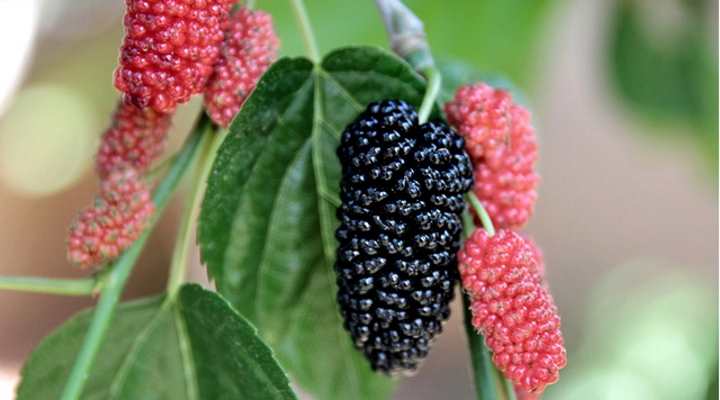
Mulberry fruit
Apart from its long, cylindrical berry-like fruit, a mulberry tree is identified by its flowers and leaves. The mulberry tree has heart-shaped, dark glossy green leaves measuring 3” to 7” (7.5 – 18 cm) long. The mulberry tree blooms in spring with long, dangling greenish flowering spikes (catkins).
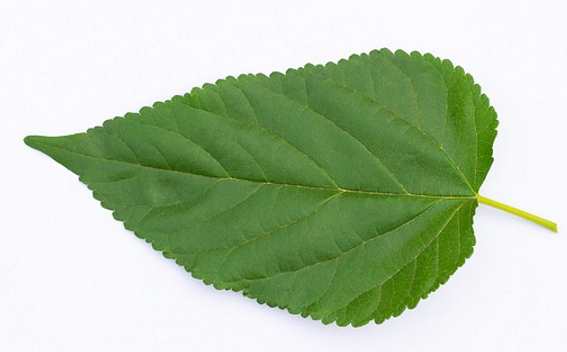
Mulberry leaf
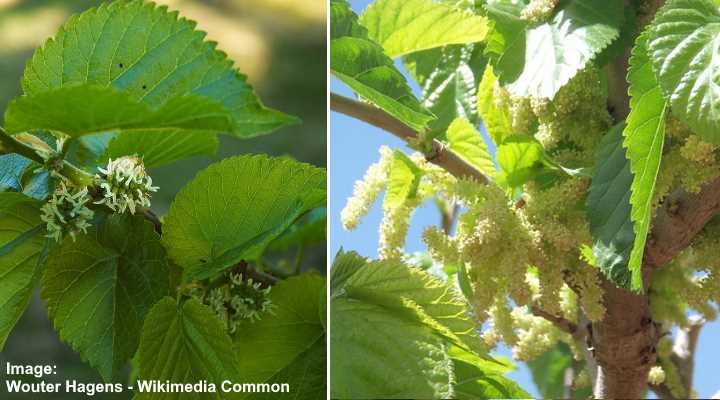
Mulberry female flowers (left) and male flowers (right)
The aggregate mulberry fruits grow on large-sized trees that are 30 to 50 ft. (9 – 15 m) tall. Mulberry trees grow in USDA zones 4 through 9. The fast-growing mulberry tree has a dense, open, rounded crown of dark green foliage that turns golden yellow in the fall.
Berry tree identification
To identify a mulberry tree, look for its long cylindrical blackberry-like fruit, large heart-shaped lobed dark green leaves, and small greenish flowers.
Common Hackberry (Celtis occidentalis)
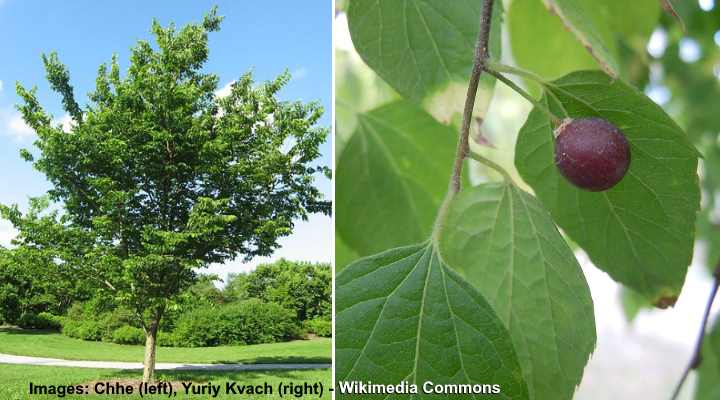
Common hackberry (Celtis occidentalis)
The hackberry tree produces dark red or purple berry-like fruit that measure about 0.3” (0.8 cm) in diameter. The small, round edible hackberry fruits emerge green and turn dark purple by fall. The globular berry has sweet flesh surrounding a tiny nut.
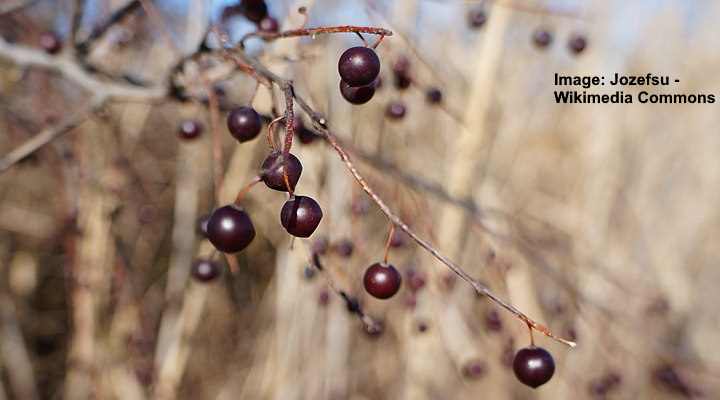
Hackberry fruits
The small dark red or purple hackberries have a sweet taste when ripe in late fall. The small fruits with edible flesh and tiny seeds also have a crunchy consistency and a slight peanut butter-like taste.
Hackberries appear in summer as small green balls growing in clusters. As the berry-like fruits ripen, they become a dark burgundy to deep purple color and a sweeter taste. The berries are ready to eat from the tree by late fall, and they may persist through winter.
The large hackberry tree is identified by its pyramidal growth habit that opens to a spreading crown. The sizable ornamental hackberry tree has lanceolate to ovate, glossy green leaves with serrated margins. The hackberry fruit tree has yellowish-green flower clusters made up of flowers with four to five petals and measuring 0.25” (0.6 cm) across.
Also called beaverwood, nettlewood, false elm, or the American hackberry, the hackberry tree typically grows 40 to 60 ft. (12 – 18 m) tall. It’s a fast-growing tree that adds between 2 and 3 ft. (0.6 – 1 m) per year in height.
Hackberry trees thrive in USDA zones 2 through 9.
Berry tree identification
To identify berries on a hackberry tree, look for clusters of small, round, berry-like drupes that are dark red or purple. Additional identification features of the tree are lance-shaped leaves with toothed margins and yellowish-green clusters of flowers
Silver Buffaloberry (Shepherdia argentea)
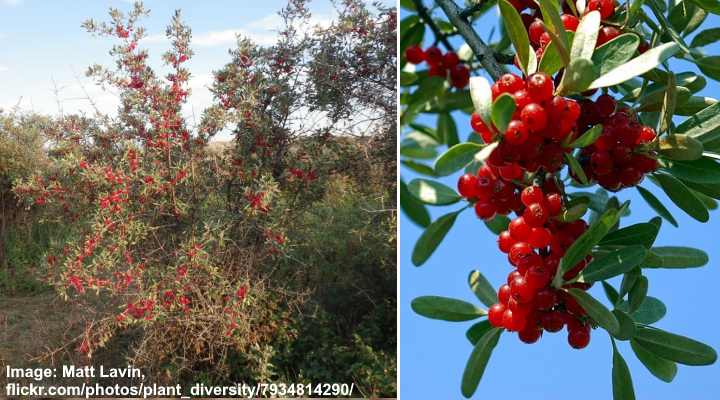
Silver buffaloberry (Shepherdia argentea)
The silver buffaloberry is a shrub-like tree that produces bright red berry-like edible drupes ready for eating in the fall. Clusters of vibrantly colored, pea-sized red berries emerge in summer and are ripe by fall. The berries have a sour, tart taste and are delicious in pies, jellies, or jams.
Silver buffaloberry fruit is identified by its bright red color and tiny white dots. The tart-tasting berries are about the size of a pea and grow abundantly on woody branches. Silver buffaloberries look like cranberries and have a similar tart taste, ideal for use in baking or preserves.
The multi-stemmed silver buffaloberry plant is typically a large shrub that you can train to grow as a tree. The shrubby tree has a loosely branching growth habit creating a rounded crown. Typically, the small fruit-bearing tree grows up to 15 ft. (4.5 m) tall. The silver buffaloberry tree thrives in USDA zones 3 through 9.
Other identifying features of a buffaloberry tree are its white or yellowish spring flowers. The tubular buffaloberry flowers appear in spring, contrasting with gray leaves that have silvery speckles. Although red berries are the tree’s primary identifying feature, some trees produce golden yellow berries.
Berry tree identification
To identify berries on the silver buffaloberry tree, look for large clusters of small, round, bright crimson red berries. The red berries look and taste like cranberries. Buffaloberry trees are also identified by their silvery-green leaves.
Panama Berry (Muntingia)
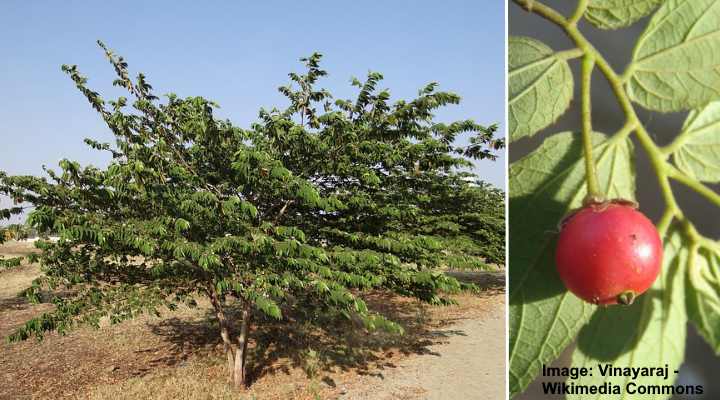
Panama berry (Muntingia)
The Panama berry tree produces large red berries that look like ripe cherries. The edible red berries emerge green before ripening to a red color. Looking like small round fruits dangling from the tree, the red berries have a sweet, fresh taste and measure about 0.6” (1.5 cm) in diameter.
Berries on the Panama berry tree grow in tropical climates. The tropical fruit tree thrives in Florida and USDA zones 9 through 11. The large berry-producing trees grow 25 – 40 ft. (7.5 – 12 m).
Apart from the round red dangling berries, the Panama berry tree has other identification features. The tree’s leaves are lanceolate, evergreen blades 2” to 5” (5 – 13 cm) long. In addition, attractive, creamy white flowers 0.75” (2 cm) wide contrast with the lush green foliage.
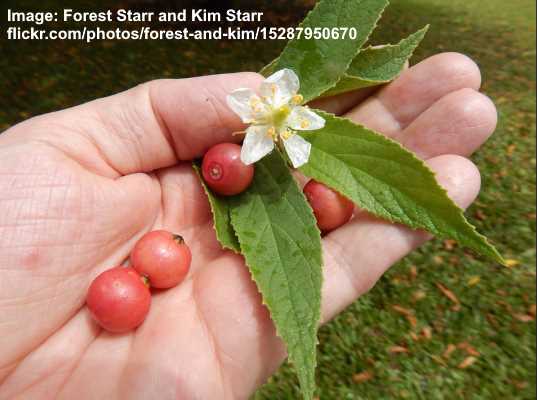
Panama berry leaves, flower and fruit
The exotic red berries from the Panama berry tree are used to make jams and baked goods.
Other names for this tropical Panama berry fruit tree include Jamaica cherry tree, West Indian cherry tree, ornamental cherry, or cotton candy berry.
Berry tree identification
Berries on the Panama berry tree are identified as small round red berries that have a sweet taste.
Serviceberry (Amelanchier)
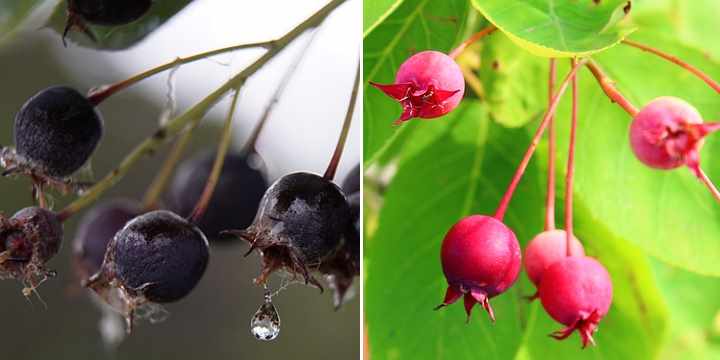
Serviceberry fruit. Left picture: mature purple serviceberry fruits. Right picture: immature red serviceberry fruits.
Serviceberry tree fruits are small red or purple berry-like pomes that look and taste like blueberries when fully ripe. The small round berries grow in open clusters and are ready for eating in June. The deciduous berry tree fruit can be eaten raw or cooked and used for making jellies or jams.
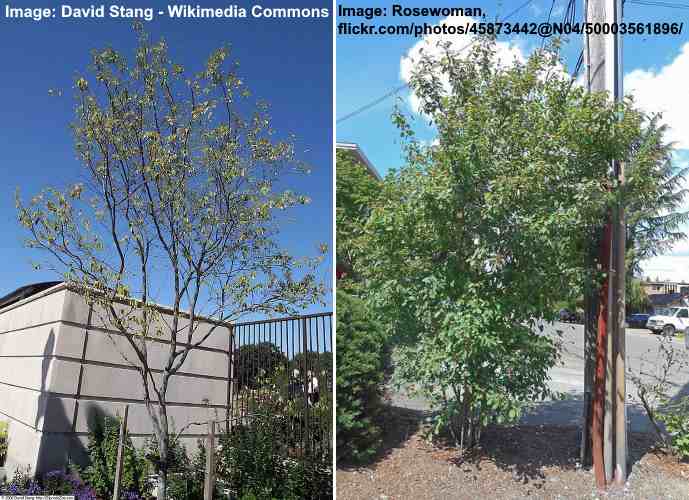
Autumn Brilliance serviceberry tree (Amelanchier × grandiflora ‘Autumn Brilliance’) grows as a multi-stemmed tree but you can remove suckers to prevent a shrubby growth
The clusters of red serviceberries grow on long stems, and each round fruit measures between 0.25” to 0.5” (0.6 to 1.3 cm) in diameter. The berries have bluish-purple color and a sweet taste when ripe.
The deliciously sweet purple serviceberry tree fruits are ready for eating in early summer. Apart from being enjoyed by humans, the sweet berries also attract many birds.
The serviceberry tree is identified by its elliptical green leaves, short-lived white or pinkish spring blooms, and charcoal gray bark. The beautiful ornamental tree grows 15 to 25 ft. (4.5 – 7.5 m) tall and has a medium growth and rounded habit.
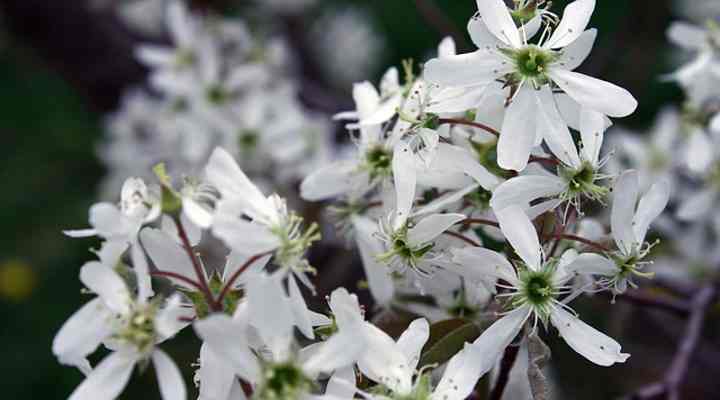
Serviceberry flowers bloom in early spring and are typically white
The serviceberry tree has pretty foliage made up of coarsely-toothed, oval leaves. These tree leaves are light-green during spring and summer before turning brilliant shades of red and orange in the fall.

Serviceberry leaves in autumn
Serviceberry trees produce abundant berries when growing in USDA zones 2 through 7 and full sun.
Serviceberry can grow as a small tree or large multi-stemmed shrub.
Berry tree identification
Berries on the serviceberry tree are identified as round to oval-shaped fruits with a purple color and taste of strawberries, blueberries, and a hint of almond.
Strawberry Tree (Arbutus unedo)
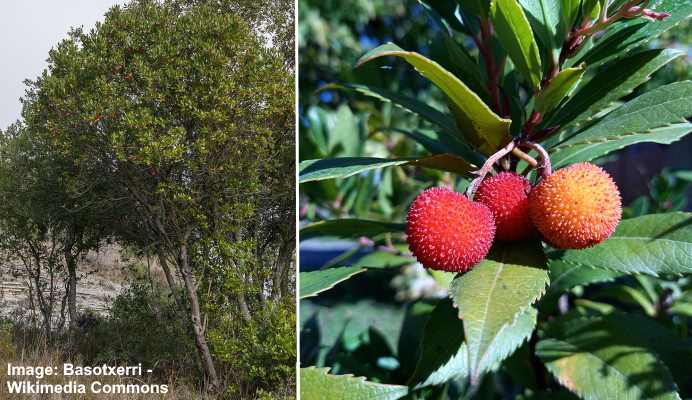
Strawberry tree (Arbutus unedo)
The strawberry tree produces red, yellow, and orange berries that look like spiky strawberries 0.4” to 1.2” (1 – 3 cm) in diameter. The red edible berries on the strawberry tree have a rough surface and sweet taste when ripe. The berries emerge on the tree yellow and slowly ripen to a rich red color.
Strawberry tree berries have soft, golden-orange flesh containing many seeds. The rough, red berries have a slight aniseed taste with a sweet-tart flavor reminiscent of peach, mango, and apricot. The seeds in the strawberry tree berries give the fruit a crunchy, mealy consistency.
Berries on the strawberry tree ripen in late summer and persist on the tree through winter.
Drooping clusters of white or pale pink bell-shaped flowers also adorn the strawberry tree from fall through mid-winter. The ripened colorful orange and red berries provide a stunning contrast with the tree’s green foliage and white flowers.
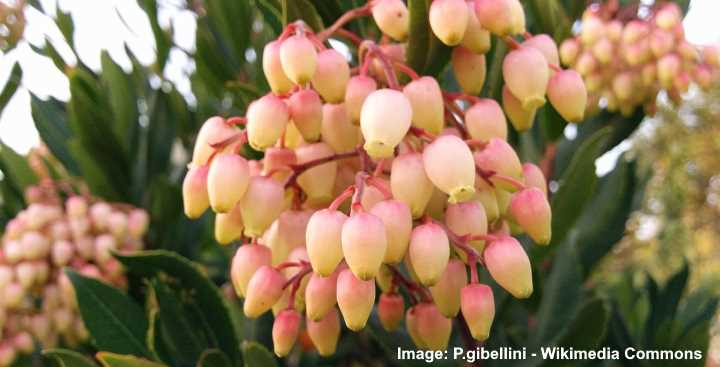
Strawberry tree flower
The evergreen strawberry tree has a rounded, spreading, vase-shaped crown and dense foliage. Apart from large oval red berries, other identifying features of the strawberry tree are gnarled branches, dark green leaves growing on red petioles, and gray-brown bark.
Strawberry trees are small evergreen trees or large shrubs. The easy-to-grow fruit trees thrive in USDA zones 7 through 10 in full sun. Despite their common name, these berry-producing trees are unrelated to the vining strawberry plant (Fragaria).
Berry tree identification
Berries from the strawberry tree are oval red berries with a bumpy, rough surface and bristle-like spikes. The round berries emerge yellow, turn bright red, and taste deliciously sweet.
Related articles:
- Mulberry Trees – Identification Guide
- Serviceberry Trees and Shrubs – Identification Guide
- Trees and Shrubs with Red Berries
